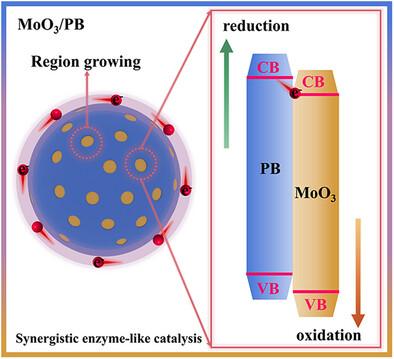簇约束纳米酶生长的区域电子转移和带调节增强催化效应
IF 12.1
2区 材料科学
Q1 CHEMISTRY, MULTIDISCIPLINARY
引用次数: 0
摘要
由于其多重结构的复杂性,普鲁士蓝复合纳米酶(PB C‐NZs)的催化机理尚未完全阐明。同时,对于PB - C - NZs的建设,目前还没有比较明确的设计理念。鉴于pbnz具有电子转移催化机制和氧化还原的内在特性,本工作提出了一种基于电子转移和能带差的新型设计理念,以提高催化活性和氧化性能。简单地说,通过原位掺杂MoO3来增加活性位点和调节能带位置来调节氧化还原能力,形成了具有区域生长的PB C‐NZs。MoO3和PB的能带重叠区可以减小带隙,提高电子传递效率。其类氧化酶性能结果表明,具有较高价带的化合物可以提高氧化性能。这证实了PB - C - NZs的类氧化酶性能因能带差异而增强。该设计理念阐明了MoO3/PB纳米酶增强酶活性的因素和电子传递机制,为后续氧化还原纳米酶的设计提供了新的思路。本文章由计算机程序翻译,如有差异,请以英文原文为准。

Regional Electron Transfer and Band Regulation by Cluster‐Constrained Nanozyme Growth for Enhanced Catalytic Effect
Due to the complexity of their multiple structures, the catalytic mechanism of Prussian blue composite nanozymes (PB C‐NZs) remain to be fully elucidated. Meanwhile, there is currently no relatively clear design concept for the construction of PB C‐NZs. Given that PBNZs have an electron transfer catalytic mechanism and intrinsic properties of redox, this work proposes a novel design concept based on electron transfer and energy band difference to improve catalytic activity and oxidation performance. In short, a PB C‐NZs with region growing is developed by in situ doping with MoO3 to increase the active sites and adjust the band position to regulate redox ability. The energy band overlap region of MoO3 and PB can be used to reduce the band gap for improving the electron transfer efficiency. And its oxidative enzyme‐like performance results show that compounds with higher valence bands can be used to improve the oxidation performance. This confirms that the oxidation enzyme‐like performance of PB C‐NZs are enhanced by energy band differences. The design concept clarifies the factors and electron transfer mechanism of the MoO3 /PB nanozyme to enhance enzyme activity and proposes a novel concept for the design of subsequent redox nanozymes.
求助全文
通过发布文献求助,成功后即可免费获取论文全文。
去求助
来源期刊

Small
工程技术-材料科学:综合
CiteScore
17.70
自引率
3.80%
发文量
1830
审稿时长
2.1 months
期刊介绍:
Small serves as an exceptional platform for both experimental and theoretical studies in fundamental and applied interdisciplinary research at the nano- and microscale. The journal offers a compelling mix of peer-reviewed Research Articles, Reviews, Perspectives, and Comments.
With a remarkable 2022 Journal Impact Factor of 13.3 (Journal Citation Reports from Clarivate Analytics, 2023), Small remains among the top multidisciplinary journals, covering a wide range of topics at the interface of materials science, chemistry, physics, engineering, medicine, and biology.
Small's readership includes biochemists, biologists, biomedical scientists, chemists, engineers, information technologists, materials scientists, physicists, and theoreticians alike.
 求助内容:
求助内容: 应助结果提醒方式:
应助结果提醒方式:


